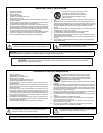
ENGLISH
8
Mute Control Connections
For mute control, use either a latching switch or a momentary
switch. The total resistance of the cable run from the switch to the
DFR22 should be less than 100 ohms.
Figure 15 shows an example of how to connect either a latching
switch or a momentary switch to the Control Input pins to mute an
input or an output.
Switch
(momentary or latching)
Ground
MUTE CONTROL PIN CONNECTIONS
Figure 15
Gain Control Connections
For gain control, use either a potentiometer or two momentary
switches (one for gain up and one for gain down). If you want to
have multiple sets of gain controls acting on the same inputs or out-
puts, use momentary switches connected in parallel. Figure 16
shows a typical connection between a potentiometer and the Con-
trol Input pins. Figure 17 shows a typical connection between two
momentary switches and the Control Input pins.
When using a potentiometer, the total resistance of the cable run
should be less than 100 ohms.
When using momentary switches, the total resistance of the cable
run should be less than 100 ohms.
NOTE: As supplied, the DFR22 control pins are configured for use
with a 10 Kohm audio taper potentiometer. However, you can use
the Potentiometer Calibration Wizard in the DFR22 software to
configure the DFR22 for use with any 10 Kohm, 20 Kohm, 50
Kohm, or 100 Kohm linear or audio taper potentiometer.
10kW Potentiometer
(Audio Taper)
GAIN CONTROL PIN CONNECTIONS USING A POTENTIOMETER
Figure 16
Switch
(momentary)
Ground
Switch
(momentary)
GAIN CONTROL PIN CONNECTIONS USING SWITCHES
Figure 17
AMX / Crestron Control Connections
You can connect an AMX or Crestron controller to the back panel
RS-232 port, using a Phoenix connector, or to the front panel
RS-232 port, using a DB-9 connector. In either case, you only need
to connect three wires: send, receive, and ground. See page 8 for
the pinout of the RS-232 ports.
To access AMX/Crestron control codes for the DFR22, visit the
DFR22 web page at http://www.shure.com/mixers/models/
DFR22.asp.















